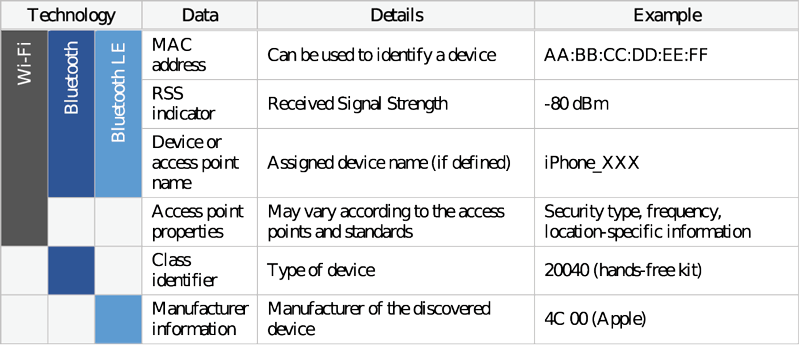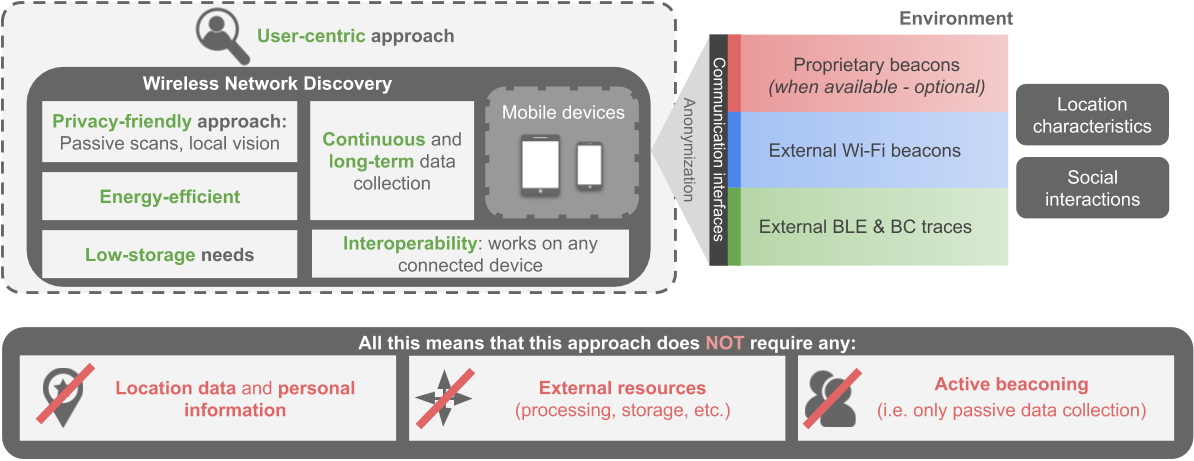by Sébastien Faye (Luxembourg Institute of Science and Technology – LIST), Tai-yu Ma (Luxembourg Institute of Socio-Economic Research – LISER), Pascal Lhoas (LIST) and Djamel Khadraoui (LIST)
The COVID-19 pandemic has given rise to many digital tools to help monitor and interrupt infection chains. Among them, contact tracing apps are a reliable means of preventing the virus from spreading further, but they suffer from a low adoption rate. This article introduces complementary approaches based on data fusion from wireless networks such as Bluetooth or Wi-Fi, which will be tested in Luxembourg in 2021 in the mobility sector and have the potential to facilitate the monitoring of social interactions in indoor environments.
Contact tracing apps rely on communication technologies to quickly identify and interrupt infection chains. Geolocation approaches have been considered for this purpose, but the most promising solutions now rely on Bluetooth and signal strength measurements, which are more respectful of user privacy. However, while these solutions may be effective at tracing an infected person’s contacts, they suffer from significant issues:
- Difficulty in adopting a mobile app: To be fully effective, these solutions must be massively adopted by the population. Convincing the end-user to install them is not an easy task, and there are still issues about data protection compliance and moving across borders.
- Indoor misinterpretations: Even the most advanced solutions are based solely on Bluetooth and do not consider the constraints of the user’s environment, which can lead to misinterpretation and false signals, particularly in buildings where walls are not an absolute barrier to wireless technologies.
- Lack of dedicated tools to monitor social distancing in workplaces: The risk of infection is higher in these environments due to frequent contact between people. However, existing solutions usually involve bulky, limited-range and privacy-invasive cameras, which are not entirely suitable for protecting professional activities and ensuring social distancing rules.
- Lack of relevant indicators/tools to assess the risk of infection: Most contact tracing approaches using wireless network data focus solely on calculating the proximity between two users. However, it is also possible to assess the potential risk of infection by looking at more detailed interaction patterns. This would provide human analysts and “disease detectives” with tools to proactively monitor the evolution of the virus.
To address these problems, we need novel methodologies and tools to monitor and assess the risk of infection in closed environments and to help manage exit strategies accordingly. We have developed an approach that continuously monitors pervasive information from people’s devices to develop meaningful social interaction indicators. Several layers of information can be exploited, but the easiest to use and illustrate relies on network discovery: the process by which devices of a network announce their presence to each other. This is usually done through dedicated messages that contain contextual information. Table 1 illustrates the information contained in Wi-Fi and Bluetooth traces, which are two of the most commonly used types of short-range networks. It has been shown that Wi-Fi traces can be analysed to discover places of interest or movements inside buildings without explicit location information. Bluetooth traces have already been used to reconstruct the path of a vehicle and for people-counting applications.

Table 1: Overview of the data available through network discovery, via Wi-Fi and Bluetooth, which is currently composed of two versions: Bluetooth classic (BC), offering a pairing mechanism between two devices, and Bluetooth Low Energy (BLE), which no requires it.
As illustrated in Figure 1, collecting and analysing network discovery data passively (i.e., listening only) and in real-time has the potential to lead to new, privacy-friendly indicators that can be estimated using graph theory and new artificial intelligence models [1, 2]. With this approach, it would be possible to generate in real time a dynamic interaction graph, which allows the intensity of interactions between individuals to be quantified. The evolution of the graph can be analysed over time without the need to install a mobile app.

Figure 1: Overview of the network discovery approach described in this article.
LIST has established expertise in this research area, having worked on both indoor geolocation and user profiling models through projects such as the H2020 project MODALES, which aims to investigate how driving behaviour correlates with vehicle emissions [L1]. Even though this project’s field of application is far removed from epidemiological management, MODALES has technological building blocks that can greatly benefit a new generation of user-centric tools for measuring social distancing indicators. One proposed solution is a mobile app to estimate in real-time the behaviour of a driver and identify his/her environment, which includes the density of vehicles and the type of road on which a user is driving, and which have a direct impact on particle emissions. Network traces can be collected passively and in real-time to dynamically estimate the users’ context and thus them in their choices. The expected accuracy is, of course, less precise than the accuracy that could be provided by cameras or LiDARs, but has the advantage of involving low storage and energy consumption while being more respectful of user privacy.
This model has the potential to be fully replicable to COVID-19 by deploying dedicated sensors in buildings or confined spaces (even buses). The sensors would passively collect network information to help understand user interactions in the area and to estimate their number and proximity in real time. Multi-network data fusion would reduce estimation errors related to the indoor environment and the discovery mechanism would not require users to install a mobile app. The social distancing indicators resulting from this approach could lead to an infection risk model, which would allow potential risk in space and time to be quantified and predicted relying on social network analysis and computer simulations of stochastic infection process. LISER has established expertise in the modelling and simulation of individual mobility patterns and behaviours [L2] and has recently developed an epidemionomic model of the COVID-19 crisis in Luxembourg [3]. All these elements could lead in the medium term to the development of solutions, such as online dashboards, to provide useful risk indicators, inform companies’ employees and prevent potential infection. This decision support system, which could also integrate simulation and optimisation elements, could enable the company manager to take rapid and relevant health measures.
Links:
[L1] https://modales-project.eu
[L2] https://www.connecting-project.lu/
References:
[1] S. Faye, F. Melakessou, D. Khadraoui: “DISCO: Ultra-Lightweight Mobility Discovery”, in Proc. of the 16th ACM Conf. on Embedded Networked Sensor Systems (pp. 341-342), 2018.
[2] S. Faye, et al.: “Characterizing user mobility using mobile sensing systems. International Journal of Distributed Sensor Networks, 13(8), 1550147717726310, 2017.
[3] M. Burzynski, F. Docquier: “Recovering from the Covid-19 crisis”, Insights from an Epidemionomic Approach, 2020.
Please contact:
Sébastien Faye, Luxembourg Institute of Science and Technology (LIST), Luxembourg
+352 275 888 4909,











